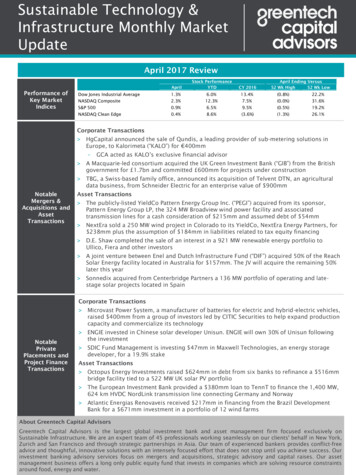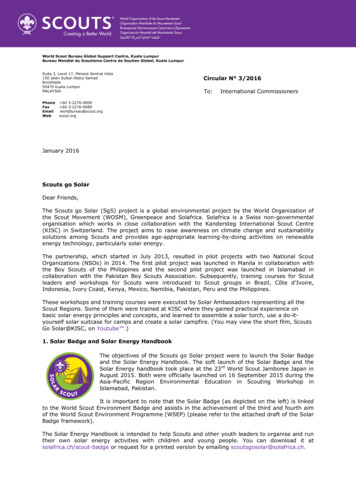
Transcription
November 2021SOLAR PV INFORMATIONThank you for the opportunity to present you with information about SolarPhotovoltaic (PV) Energy Systems. This document will give you a brief descriptionof how the Solar PV System will work for a typical project, the system costs, andsome recommendations.How the Solar PV system for your project will workSolar photovoltaic (PV) energy systems for most homes and businesses in this areaare grid-tie systems. For a grid-tie solar PV system, solar panels are mounted onthe south facing roof of the building or on an adjacent structure, where they aremost exposed to the sun.The solar panels willproduce direct current(DC) electricity when thesun is available. The DCelectricity passes throughwiring to an inverterwhich converts it toalternating current (AC)electricity which iscompatible with thewiring, lighting andappliances in yourbuilding. When the sun isnot available, electricity isprovided by the electricutility grid. The solar PVarray is normally designed so that during the daytime, when the sunshine isavailable, excess energy will be produced. This excess energy will pass backwardthrough the electric meter and into the electric grid. In most cases, you will receivefull or partial credit on your electric bill for this excess electricity. For grid-tiesystems, when the electric grid is not available, the solar energy system will notproduce electricity. These systems typically cost 2 to 3 per Watt of installedsolar power.Some customers utilize another type of system called a grid-tie with batterybackup system. This system is more complicated than a standard grid-tie system.For a grid-tie with battery backup system, solar panels are mounted on the southfacing roof of the building where they are most exposed to the sun. The solar panelswill produce DC electricity when the sun is available. The DC electricity passesthrough wiring to a charge controller where it either charges a bank of batteries or (ifthe batteries are fully charged) it passes the electricity to an inverter which convertsit to AC electricity. This electricity is used by your building. Excess energy isproduced just like with a grid-tie PV system.
The main difference between the two systems from a functional standpointoccurs when the utility grid is not operating. For a grid-tie system, there is nopower from the solar PV array and no power from the utility when the grid isdown. For a grid-tie with battery backup system, the building will receiveelectricity from the bank of batteries and the batteries are being continuouslyrecharged by the solar PVarray. In most cases,however, the bank ofbatteries is not large enoughto supply all of the powerneeds of the building,therefore only essentialelectrical needs are typicallysupplied.The functional differencebetween the two systemsresults in a morecomplicated and moreexpensive design. There arethree main components thatare added to the grid-tiewith battery backup system:(1) A controller which monitors the status of the solar panels, batteries, andthe utility grid. (2) A bank of batteries which provides power when the utilitygrid is down. (3) A distribution panel which contains the circuitry for loadswhich will be powered by battery backup.The two system types also have other differences. The two systems both haveinverters, but the inverters have different properties. Grid-tie inverters arecapable of converting DC electricity from high voltage solar arrays. Grid-tiewith battery backup inverters convert DC electricity from low voltage batterybanks and low voltage solar arrays. As a result, solar array wiring is differentfor the two types of systems. Grid-tie with battery backup systems typicallycost 3 to 5 per watt of installed solar power.System Design:The size of a solar energy system is normally determined by the amount ofenergy that the building will require and the proportion of the electricity thatyou would like to provide with the solar energy system. The average home inTexas uses about 10,000 to 16,000 kWh/year of electricity. Most solar energysystems are designed to provide 50% to 100% of these requirements.The size of a solar PV system is designated by the number of Standard TestCondition (STC) Watts that it produces. Typical system sizes for residencesrange from 3,000 Watts to 10,000 Watts. A 10,000 Watt (also called a 10kilowatt or 10 kW) system will produce up to 15,000 kwh/year under idealconditions. This is enough to offset 100% of the electricity required by atypical home.
The ideal location to place aSolar PV system on a home ison the south facing roof at a7/12 to 8/12 pitch. This roofmust be unshaded from 10:00a.m. to 3:00 p.m. in order toproduce the optimum amountof energy. Systems canproduce up to 90% ofoptimum production on roofsthat are facing due east or duewest as long as there are noshading conditions. Solar PV systems usually require about 60 square ft. forevery 1,000 watts. A 5,000 watt system will require about 300 square feet ofroof area.If there is not enough space on the roof for a Solar PV energy system, thepanels can be placed on a ground mounted framework, a pole mount, or evenon a canopy or carport. Pictures of some mounting situations are shownbelow. More examples can be found at our website:http://www.greenlifetechinc.comSystem Costs:The cost of a solar PV system isdetermined by the size of thesystem and the site conditions.Also, the federal governmentwill provide a tax credit of 26%of the cost of a solar PV system.The federal government will alsoallow rapid depreciation (over aperiod of 4 years or less) for acommercial solar PV system.Canopy Mount SystemsPresented below is an estimatefor a 5,000 Watt, 10,000 Watt,15,000 Watt and 20,000 Watt grid-tie, roof mount system. Also presented is the costof a 5,000 Watt grid-tie with battery backup and a 10,000 Watt battery backup systemand a 50 kW commercial grid-tie system. The actual bid for your system may varyfrom these prices depending on financing, the mounting situation, and the electricalsystem of your building.
System Cost/Performance Summary (see below for net cost calculation)System5.0 kW grid-tie10.0 kW grid-tie15.0 kW grid-tie20.0 kW grid-tie5.0 kW battery10.0 kW batteryTotal Cost Net Cost 16,600 12,284 30,000 22,200 42,000 31,080 52,500 38,850 26,500 19,610 40,200 29,748Payment 99 179 241 312 144 210EnergyLifetime Savings7,400 kWh/yr 36,84514,800 kWh/yr 76,74522,200 kWh/yr 106,23029,600 kWh/yr 143,8537,000 kWh/yr 27,11214,000 kWh/yr 65,256Note: The energy production for each system is based on ideal site conditionsTo offset the cost of solar PV systems, the federal government is offering taxcredits of 26% of the cost of the system for homes. The cost of the 5.0 kWsystem will be: 16,600Total System Cost (includes full service, parts, delivery,installation, warranty, sales tax)( 4,316) Federal Tax Credit (26% of total cost) 12,284Total Net Cost of System after taxes (This assumes that theincentives are taxable. Please check all tax calculations withyour accountant)Pole Mount SystemSystem SpecificationsThese systems will include solarpanels mounted on the southfacing roof and invertersmounted on your building nearthe electric meter and all othermeters and disconnects which arerequired by the NEC and the localincentive programs. We canprovide most any brand of solarmodule or inverter, but wetypically use REC Group solarmodules and SMA or SolarEdge orSchneider inverters. The solarmodules have a 25 year warranty and the inverters have a 10 to 12 year warranty.This is top of the line equipment and the balance of system components (mountinghardware, wiring, etc.) are composed of stainless steel and aluminum and aredesigned to last for the life of the system. All roof attachments are installed withflashing rather than caulk so that the possibility of a roof leak is eliminated.
Benefits of Solar- This system will offset your utility cost.- This system will benefit the environment by offsetting the production of:CO2, the leading greenhouse gasNOx, which creates smogSO2, which causes acid rainParticulates that cause asthma- This system will decrease our need for foreign oil.- It will provide electricity which is exempt from future energy cost increases for yourhome or business for 25 or more years.- It will increase the value of your home by 30,000 on the average home.- For battery based systems, it will provide power when the utility grid is notavailable.The Next StepGreenLife Technologies is acertified installer for the Oncor,AEP, Entergy, Austin Energy andother incentive programs. Wehave engineers with over 25years of experience and masterelectricians with over 40 years ofexperience on staff. We haveinstalled grid-tie, grid-tie withbattery backup and off-gridsystems on roofs, ground mounts,pole mounts, pole mounts withtracking and canopy mountedsystems.Ground Mount SystemIf you find that you are interested in installing a solar PV system, I hope that you willallow GreenLife Technologies to serve you. We will travel to your site and makeaccurate measurements to determine the best design for your system. We willdiscuss with you and make final decisions on the specifications of the system, suchas mounting system, component placement, etc. We will install your system andwarrant it for 5 years (25 years on the solar panels). An owner/operator’s manualwill be provided.Let us know if you have any questions or are ready to talk about a custom bid!Sincerely,Gary RamirezOwner
Solar photovoltaic (PV) energy systems for most homes and businesses in this area are grid-tie systems. For a grid-tie solar PV system, solar panels are mounted on the south facing roof of the building or on an adjacent structure, where they are most exposed to the sun. The solar panels will produce direct current (DC) electricity when the










